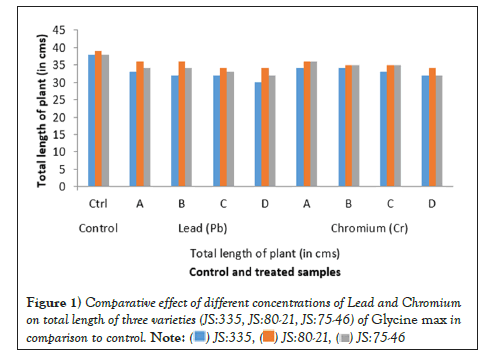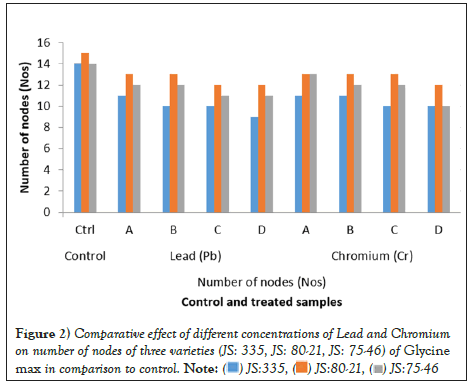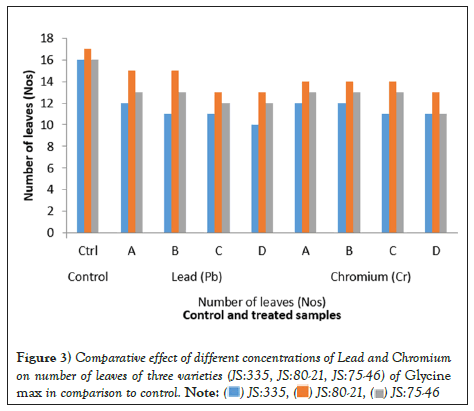Agricultural and Biological Research
RNI # 24/103/2012-R1
Research Article - (2023) Volume 39, Issue 5
Heavy metal like lead and chromium present in environment in large quantities cause a severe environmental concern. Significant risks to the environment and agriculture are posed by heavy metal contamination of the air, water, and soil as a result of increased urbanization and industrialization. Because of its permanence and high toxicity, heavy metal contamination in soils can have a negative impact on neighboring ecosystems, groundwater, agricultural production, and human health. Plants growing in metal-contaminated soil collect heavy metals in their tissues, which may negatively affect the morphology of the plant. The present study was carried out to determine the effect of different concentrations (50 ml, 100 ml, 150 ml and 200 ml) of chromium and lead on morphological attributes of three varieties (JS:335), (JS:80-21), (JS:75-46) of soybean (Glycine max). According to the results of the present research, Glycine max plants' overall length, number of nodes, and number of leaves decreased after being exposed to Pb and Cr. With increasing concentrations of heavy metals, the form of the leaves of treated plants significantly altered from ovoid to heart and oval shapes. Among the three different varieties (JS:335), (JS:80-21), (JS:75-46) of Glycine max (soybean) JS:335 showed extreme reduction and the JS:80-21 showed least reduction in the growth of a plant. Lead treatment proved more toxic than chromium treatment for all the three different varieties (JS:335), (JS:80-21), (JS:75-46) of Glycine max.
Haberler
Haberler
Haberler
Haberler
Haberler
Haberler
Haberler
Haberler
Haberler
Haberler
Haberler
Haberler
Haberler
Haberler
Haberler
Haberler
Haberler
Haberler
Haberler
Haberler
Haberler
Haberler
Haberler
Haberler
Haberler
Haberler
Haberler
Haberler
Haberler
Haberler
Haberler
Haberler
Haberler
Haberler
Haberler
Haberler
Haberler
Haberler
Haberler
Haberler
Haberler
Haberler
Haberler
Haberler
Haberler
Haberler
Haberler
Haberler
Haberler
Haberler
Heavy metal; Chromium; Lead; Glycine max; Morphological parameters
Heavy metals are elements that are found naturally on Earth [1]. Because they are toxic, persistent, and non-degradable, heavy metals are among the most dangerous contaminants in the aquatic environment [2,3]. Significant hazards to the environment and agriculture are posed by heavy metal contamination of the air, water, and soil as a result of rising urbanization and industrialization. Due to its persistence and high toxicity, heavy metal pollution in soils can have detrimental effects on nearby ecosystems, groundwater, agricultural productivity, and human health. This has a significant effect on humanity because agriculture cannot be sustained without healthy soils [4]. According to numerous studies, the main risk associated with heavy metal contamination of agricultural soils is toxic metal accumulation in crops. Soybean is frequently grown in stressful environments; such as soils with high arsenic concentrations [5,6]. Soybean (Glycine max) contains protein content of approximately 35-50% of protein depending on its origin. It is a significant source of protein for humans and is also beneficial for animal nutrition. A good source of several necessary amino acids is soybean protein. Phytoestrogens, conjugated carbohydrates, inorganic compounds, fatty acids (soybean oil), and inorganic substances are also found in large quantities in soybean. A significant amount of unsaturated fatty acids, B vitamins, and minerals like nitrogen, potassium, magnesium, iron, calcium, and phosphorus enhance their nutritional value [7]. Vegetable soybean is regarded as a functional food crop because it is abundant in phytochemicals that are good for humans [8]. The growth of soybean plants exposed to arsenic has shown severe damage: crop yield and root and shoot biomass are both significantly reduced [9] heavy metals includes lead and chromium are potentially toxic and are the main sources of environmental pollution. One of the most prevalent and widely dispersed toxic elements in soil is lead (Pb). Plant morphology, growth, and photosynthetic processes are negatively impacted by it. Spartiana alterniflora and Pinus helipensis seed germination are known to be inhibited by lead [10]. Pb reduces the dry mass of roots and shoots, germination index, percentage of germination, and root/shoot length. Some plant metabolic processes, including the synthesis of nitrogenous compounds, the metabolism of carbohydrates, and the absorption of water, are inhibited by lead [11,12]. In addition to altering soil microorganisms and their activities, which worsened soil fertility, pb contamination in soils also had a direct impact on changes in physiological indices, which further decreased yield [13]. There are many different ways that Cr toxicity in plants can be seen, from decreased yield to effects on leaf and root growth to inhibition of enzymatic activities and mutagenesis. Chromium adverse effects on plant height and shoot growth [14]. The purpose of this research was to look at how lead and chromium stress affected the morphological characteristics of soybean.
Plant materials and experimental design
Certified seeds of three varieties of soybean (Glycine max) (JS:335), (JS:80-21), (JS:75-46) were procured from Vindhya herbal testing laboratory and nursery Bhopal, M.P India. Seeds were surface sterilized with 0.1% HgCl2 (mercuric chloride) for two minutes. The seeds were washed with distilled water twice and air dried. Soil was divided in 27 parts of 4 kg each. 3 parts each were treated with four different concentrations i.e., 50 ml, 100 ml, 150 ml and 200 ml of two heavy metals Lead (II) nitrate and Potassium dichromate. Seeds were sown at 2-3 cm dept in pot and watering was done once in two days till transfer of plantlets for experiments all experimental pots were placed outdoor for growing after reaching the maturity stage the plants were removed and were used for morphological analysis. Total length, number of nodes, number of leaves and shape of leaves of plants was observed as per study of Kumar et al., [15].
Comparative effect of heavy metals on morphology of different varieties of soybean plant
Effect of heavy metal on total length of plant: The effect of different concentrations of heavy metals (lead and chromium) on the total length of treated plants in comparison to control were evaluated after harvesting. The maximum reduction in total length of plant was observed at 200 ml treatment in JS:335 followed by JS:75-46 and JS:80-21 under lead stress. Similarly, in chromium treatment maximum reduction in total length of treated plant were observed at 200 ml treatment in JS:335 followed by JS:75-46, minimum decrease at 200 ml was observed in JS:80-21. as shown in Figure 1.

Figure 1: Comparative effect of different concentrations of Lead and Chromium
on total length of three varieties (JS:335, JS:80-21, JS:75-46) of Glycine max in
comparison to control. 
Effect of heavy metal on number of nodes of plant: The effect of different concentrations of heavy metals (lead and chromium) on the number of nodes of treated plants in comparison to control were evaluated after harvesting. The maximum reduction in number of nodes of treated plant was observed at 200 ml treatment in JS:335 followed by JS:75-46, minimum reduction in JS:80-21 under lead stress. Similarly, in chromium treatment maximum reduction in number of nodes of treated plant were observed at 200 ml treatment in JS:335 followed by JS:75-46, minimum decrease at 200 ml was shown in JS:80-21 as shown in Figure 2.

Figure 2: Comparative effect of different concentrations of Lead and Chromium
on number of nodes of three varieties (JS: 335, JS: 80-21, JS: 75-46) of Glycine
max in comparison to control. 
Effect of heavy metal on number of leaves of plant: The effect of different concentrations of heavy metals (lead and chromium) on the number of leaves of treated plants in comparison to control were evaluated after harvesting. The maximum reduction in number of leaves of treated plant was observed at 200 ml treatment in JS:335 followed by JS:75-46, minimum reduction in JS:80-21 under lead stress. Similarly, in chromium treatment maximum reduction in number of leaves of treated plant were observed at 200 ml treatment in JS:335 followed by JS:75-46, minimum decrease at 200 ml was shown in JS:80-21 as shown in Figure 3.

Figure 3: Comparative effect of different concentrations of Lead and Chromium
on number of leaves of three varieties (JS:335, JS:80-21, JS:75-46) of Glycine
max in comparison to control. 
Effect of heavy metal on shape leaves: The effect of different concentrations of heavy metals (lead and chromium) on the shape of leaves of treated plants in comparison to control were evaluated after harvesting. Pb and Cr treated plants showed heart and oval shaped leaves over the ovoid shaped leaves in untreated plants as shown in Table 1.
| Variety | Shape of leaves | ||||||||
|---|---|---|---|---|---|---|---|---|---|
| Control | Lead (Pb) | Chromium (Cr) | |||||||
| Ctrl | A | B | C | D | A | B | C | D | |
| JS:335 | Ovoid | Heart- shaped | Heart-shaped | Heart-shaped | Heart-shaped | Oval | Oval | Oval | Oval |
| JS:80-21 | Ovoid | Ovoid | Ovoid | Ovoid | Ovoid | Oval | Oval | Oval | Oval |
| JS:75-46 | Ovoid | Ovoid | Ovoid | Ovoid | Ovoid | Oval | Oval | Oval | Oval |
Table 1: Shape of leaves of treated plants in comparison to control were evaluated after harvesting.
The three types of Glycine max (soybean) treated with four different quantities of lead (Pb), chromium (Cr), and water (50 ml, 100 ml, 150 ml, and 200 ml) were used in the current investigation (Cr). In 2015, Kumar et al., [15] conducted research that revealed morphological features that were observed following the heavy metal treatment in terms of overall length, number of nodes, number of leaves, and shape of leaves.
The data included in Table 2 demonstrates that the Glycine max plant exhibits a reduction in root length, number of nodes, and leaf number at all concentrations over control following lead (Pb) and chromium (Cr) treatments (50, 100, 150, and 200 ml). In the treated plants, the shape of the leaves was also altered. More harmful than chromium was found to be lead (Pb). Highest reduction in total length of plant with Pb treatment was seen at 200 ml in JS:335, followed by 15.8% at 200 ml in JS:75-46, and 12.8% at 200 ml of heavy metal in JS:80-21. The number of nodes was reduced to a maximum of 35.71% at 200 ml dosages in JS:335, followed by a minimum reduction of 20.0% at 200ml in JS:80-21, and a maximum reduction of 21.0% at 200 ml in JS:75-46. In terms of the number of leaves, JS:335 observed the greatest reduction at 200 ml of Pb (37.5%) and the least reduction at 200 ml (23.52%).
| Variety | Treatment | Doses | Length of plant (in cms) | Number of nodes (Nos) | Number of leaves (Nos) | Shape of leaves |
|---|---|---|---|---|---|---|
| JS:335 | Control | A Ctrl | 38 | 14 | 16 | Ovoid |
| Lead (Pb) | AL1 | 33 | 11 | 12 | Heart-shaped | |
| AL2 | 32 | 10 | 11 | Heart-shaped | ||
| AL3 | 32 | 10 | 11 | Heart-shaped | ||
| AL4 | 30 | 9 | 10 | Heart-shaped | ||
| Chromium (Cr) | AC1 | 34 | 11 | 12 | Oval | |
| AC2 | 34 | 11 | 12 | Oval | ||
| AC3 | 33 | 10 | 11 | Oval | ||
| AC4 | 32 | 10 | 11 | Oval | ||
| JS:80-21 | Control | B Ctrl | 39 | 15 | 17 | Ovoid |
| Lead (Pb) | BL1 | 36 | 13 | 15 | Ovoid | |
| BL2 | 36 | 13 | 15 | Ovoid | ||
| BL3 | 34 | 12 | 13 | Ovoid | ||
| BL4 | 34 | 12 | 13 | Ovoid | ||
| Chromium (Cr) | BC1 | 36 | 13 | 14 | Oval | |
| BC2 | 35 | 13 | 14 | Oval | ||
| BC3 | 35 | 13 | 14 | Oval | ||
| BC4 | 34 | 12 | 13 | Oval | ||
| JS:75-46 | Control | C Ctrl | 38 | 14 | 16 | Ovoid |
| Lead (Pb) | CL1 | 34 | 12 | 13 | Ovoid | |
| CL2 | 34 | 12 | 13 | Ovoid | ||
| CL3 | 33 | 11 | 12 | Ovoid | ||
| CL4 | 32 | 11 | 12 | Ovoid | ||
| Chromium (Cr) | CC1 | 36 | 13 | 13 | Oval | |
| CC2 | 35 | 12 | 13 | Oval | ||
| CC3 | 35 | 12 | 13 | Oval | ||
| CC4 | 32 | 10 | 11 | Oval |
Table 2: The effect of different concentrations of heavy metals (Lead and Chromium) on total length of plant.
Similarly, in case of Cr treatment maximum decrease of 21.05% in total length of treated plants was observed at 200 ml treatment in JS:335 followed by 15.7% in JS:75-46, and minimum decrease of 12.8% at 200 ml was shown in JS:80-21. The obtained data of number of nodes showed that more reduction was found at 200 ml (28.57) in JS:335 and JS:75-46 and minimum decrease at 200 ml (20.0%) in JS:80-21 plants. The maximum decrease in the number of leaves was also found at 200 ml (31.25) in JS:335 and JS:75-46 and minimum (23.52%) at 200 ml in JS:80-21treated plants. Besides the reduction in the total length, no. of nodes and leaves in Pb and Cr treated plants, the shape of leaves also changed. Pb and Cr treated plants showed heart and oval shaped leaves over the ovoid shaped leaves in untreated plants. The investigation revealed significant reduction in total length for Glycine max plants in Pb treatment than Cr treated plants. A concentration dependent decrease in total length over control was observed in all the three varieties (JS:335), (JS:80-21), (JS:75-46) of Glycine max. The results obtained from this study indicate that excess of heavy metal causes a variety of toxicity symptoms in plants, such as reduced growth. According to Eun et al., the reduction in plant growth during stress is due to low water potential, hampered nutrient uptake and secondary stress such as oxidative stress. Pb treatment had a greater influence on these parameters than both Cr and Pb treatments combined. It is widely known that the growth characteristics fresh mass, dry mass, shoot and root length, photosynthetic pigments, and protein are all decreased by both Cr and Pb.
In conclusion, our results indicated that the exposure of Glycine max to Pb and Cr resulted in a decrease in total length, number of nodes and number of leaves. The shape of leaves in case of treated plants was also changed from ovoid to heart and oval shapes, at higher concentration of heavy metals. Among the three varieties (JS:335), (JS:80-21), (JS:75-46) of Glycine max, JS:335 showed maximum reduction and the JS:80-21 showed least less reduction in the growth. Lead proved more toxic than chromium for all the three varieties of Glycine max. To examine the correct hazardous signal pathways of heavy metals revealed by plants treated, further research of the molecular mechanism is still required.
[Crossref] [Google Scholar] [PubMed]
[Crossref] [Google Scholar] [PubMed]
[Crossref] [Google Scholar] [PubMed]
[Crossref] [Google Scholar] [PubMed]
Citation: Gebremedhn G. Morphological attributes of Glycine max (Soybean). AGBIR.2023;39(5):657-660.
Received: 17-Aug-2023, Manuscript No. AGBIR-23-110526; , Pre QC No. AGBIR-23-110526 (PQ); Editor assigned: 21-Aug-2023, Pre QC No. AGBIR-23-110526 (PQ); Reviewed: 04-Sep-2023, QC No. AGBIR-23-110526; Revised: 12-Sep-2023, Manuscript No. AGBIR-23-110526 (R); Published: 19-Sep-2023, DOI: 10.35248/0970-1907.23.39.579- 582
Copyright: This open-access article is distributed under the terms of the Creative Commons Attribution Non-Commercial License (CC BY-NC) (http://creativecommons.org/licenses/by-nc/4.0/), which permits reuse, distribution and reproduction of the article, provided that the original work is properly cited and the reuse is restricted to noncommercial purposes. For commercial reuse, contact reprints@pulsus.com This is an open access article distributed under the terms of the Creative Commons Attribution License, which permits unrestricted use, distribution, and reproduction in any medium, provided the original work is properly cited.
